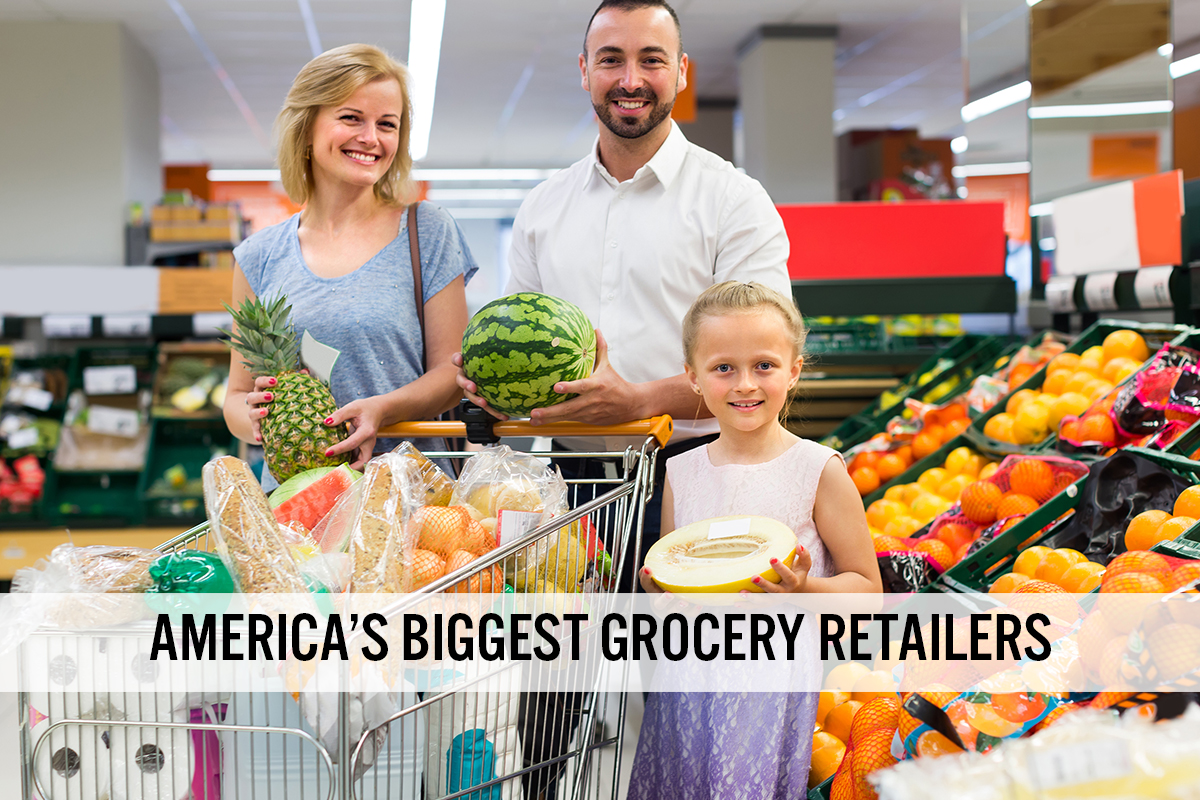
DIpil Das
Introduction
In this report, we explore the competitive landscape of the US grocery market by analyzing various performance metrics for its major players. We also discuss the companies’ propositions and typical customer base, as well as providing commentary on their business strategies.America’s Biggest Grocery Retailers: Coresight Research Analysis
We analyze the top eight US grocery retailers, by revenue: Walmart US, Kroger, Costco, Albertsons, Ahold Delhaize, Publix, Sam’s Club and Target. We compare their performance over the past five fiscal years (year-end dates differ, as specified under each figure). 1. Rankings and Trajectories Topline Revenue Mass merchandiser Walmart leads the US grocery market by revenue. The retailer’s annual US grocery sales are more than double those of second-placed Kroger and almost three times those of Costco, which comes in third. Coresight Research’s US Consumer Tracker (our weekly survey series) has consistently found that around half of all respondents buy food products from Walmart. Kroger’s top line is nearly double that of Albertsons, the second-largest pure-play grocer in the US, although the latter has closed that gap to some degree, growing at a CAGR of 4.7% from 2017 to 2021, versus Kroger’s 2.8% growth in the same period, we calculate.Costco continues to comfortably outperform its wholesale rival Sam’s Club—which is owned by Walmart—in annual grocery sales, despite having a lower store footprint than the latter in the US.
Figure 1. Leading US Grocery Retailers: US Revenues (USD Bil.) [wpdatatable id=2117 table_view=regular]
Year ends for fiscal 2021: January 31, 2022, at Walmart and Sam’s Club; January 29, 2022, at Kroger and Target; August 29, 2021, at Costco; February 26, 2022, at Albertsons; January 2, 2022, at Ahold Delhaize; December 25, 2021, at Publix Source: Company reports/Coresight Research Comparable Sales Growth Pure-play grocers Albertsons, Kroger and Publix did not have significant exposure to non-discretionary categories and thus saw strong comparable sales growth in pandemic-impacted 2020, outpacing overall US grocery market growth, which Coresight Research estimates at 12.5%. While their comparable sales accelerated, Walmart and Costco underperformed the pure-play food retailers given their exposure to discretionary categories such as general merchandise and apparel. All listed retailers saw a considerable jump in their store sales in 2020, driven by growth in average ticket size amid increased pandemic-driven demand and consolidated shopping trips. Most retailers saw their comparable sales taper off in 2021, partly due to demand comparatives offset by strong consumer spending from government stimulus.
Figure 2. Leading US Grocery Retailers: Comparable Sales Growth (YoY % Change) [wpdatatable id=2118 table_view=regular]
Year ends for fiscal 2021: January 31, 2022, at Walmart and Sam’s Club; January 29, 2022, at Kroger and Target; August 29, 2021, at Costco; February 26, 2022, at Albertsons; January 2, 2022, at Ahold Delhaize; December 25, 2021, at Publix Source: Company reports Operating Margin Publix outperforms the selected retailers in this report in terms of margin growth. Its operating margin was more than three times that of Kroger, more than twice that of Albertsons and well above the 5.5% reported by Walmart US in 2021, likely due to tighter cost management and premium positioning (Publix prices its products higher than supermarket retailers Kroger and Albertsons.) Albertsons and Sam’s Club expanded their margins consistently from 2017 to 2021. Despite having a substantial scale, Kroger posted the lowest margins than other retailers in 2020 and 2021. Albertsons outpaced Kroger in 2020 and widened that gap in 2021. All the retailers in the list (except Ahold Delhaize US and Publix) reported an increase in operating margin in 2021. Publix noted in its annual report that the operating margin in 2021 decreased compared to 2020 due to lower gross profits caused by increased shrinkage and distribution costs. Ahold Delhaize said the decline was mainly due to higher supply chain costs, further impacted by inflationary pressure and lower labor productivity.
Figure 3. Leading US Grocery Retailers: Operating Margins (%) [wpdatatable id=2119 table_view=regular]
Year ends for fiscal 2021: January 31, 2022, at Walmart and Sam’s Club; January 29, 2022, at Kroger and Target; August 29, 2021, at Costco; February 26, 2022, at Albertsons; January 2, 2022, at Ahold Delhaize; December 25, 2021, at Publix Source: Company reports Store Numbers Walmart US leads by store count, giving it a scale advantage in a fragmented industry. However, the retailer has been reducing its store footprint, with its store network decreasing from 4,761 in 2017 to 4,742 in 2021. Similarly, Kroger’s total store count shrank by 56 stores from 2017 to 2021, while its rival food retailer, Albertsons, reduced its store count by 42. The remaining retailers on the list have expanded their brick-and-mortar footprint in the same period.
Figure 4. Leading US Grocery Retailers: US Store Count [wpdatatable id=2120 table_view=regular]
Year ends for fiscal 2021: January 31, 2022, at Walmart and Sam’s Club; January 29, 2022, at Kroger and Target; August 29, 2021, at Costco; February 26, 2022, at Albertsons; January 2, 2022, at Ahold Delhaize; December 25, 2021, at Publix Source: Company reports 2. Positioning and Proposition In Figure 5, we discuss the selected grocery retailers’ propositions and positioning, typical customer and product offerings.
Figure 5. Leading US Grocery Retailers: Proposition and Positioning, Typical Customer and Product Offering Comparison [wpdatatable id=2121 table_view=regular]
*Based on data from Coresight Research’s US Consumer Tracker weekly surveys, analyzing over 7,000 responses between June and September 20, 2021 Source: Company reports/Coresight Research 3. Strategy and Analyst Commentary We present the selected retailers’ strategies and give our analysis in the table below.
Figure 6. Leading US Grocery Retailers: Strategy and Analyst Commentary [wpdatatable id=2122 table_view=regular]
Source: Company reports/Coresight Research